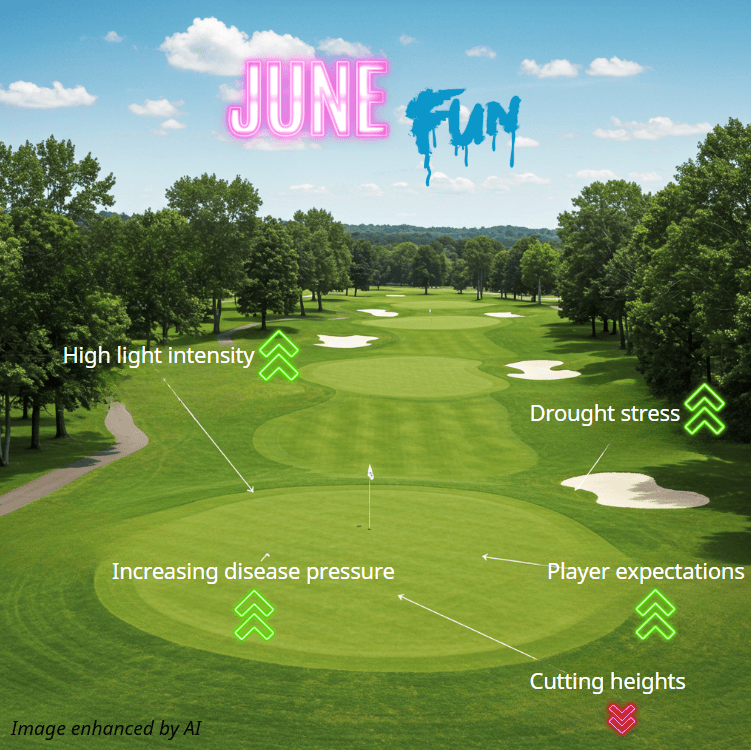- Heat stress – increasing
- Drought stress – increasing
- Cutting heights – decreasing
- Light intensity – increasing
- Player expectation – increasing
- Staff holidays during this period – increasing
If you have something in your program to help you manage all of the above as they come knocking, then you can buckle up and enjoy the ride.
It seems that no two seasons are the same year on year in recent times, so the modern turf manager has to be ready for any eventuality.
Each of the agronomic stresses mentioned above (and others not mentioned) are survivable.
Turf grass plants are highly adaptable, and are able to ‘make good’ in a broad range of conditions.
Issues tend to pop up when we get these stress factors layering up – in months like June, which can set the tone for the rest of the summer season.
Disease
The impact of summer diseases (I’m thinking anthracnose & dollar spot mainly), is going to depend on a few interlinked factors:
Grass species susceptibility
Different grasses and cultivars will have different tolerances and possible resistances to given diseases.
Long term this is a really good place to invest time and energy, speak to seed growers and find seeds which may give you the edge for your challenges.
It’s not going to help much in season – if you have a 90% poa greens sward, species transition via overseeding will not be completed this year.
But still important to start building for the future.
Condition of the turf
Even a fairly disease tolerant variety can be hit badly if the sward is in bad condition from ongoing or prolonged stress factors.
This is not always easily visible, so we need to do what we can to manage turf stress.
Thinking about this season where we’ve had drought stress in the spring when we should be putting down good roots for the season, we need to be extra vigilant.
If I was building an “anthracnose wedding cake” minimal rooting would be a great bottom layer to that cake.
Disease pressure
Like grass tolerance and turf stress, disease pressure is also a sliding scale.
For example: If you have a susceptible turf grass but it’s really ‘happy’, it takes a higher diseases pressure to lead to an outbreak of disease.
Disease pressure is built by conducive environmental (weather) conditions.
Generally higher temperatures and higher leaf moisture lead to better breeding conditions for dollar spot and anthracnose.
The warmer it is the faster the diseases can breed and spread. There is an upper limit for temperature for these diseases, but we don’t really hit those levels here.
This can’t be done in the absence of moisture, be that high humidity or long periods of leaf wetness.
Heat + moisture is the basic formula for fungal growth.
Using digital tools to help monitor conditions in season can be a powerful tool to assist – think Turf Advisor.
Your interventions
The actions you take in periods of disease pressure help you mitigate any impact on the turf. Know what you want, when, so you have it ready if conditions begin to push in the direction of an outbreak.
Preventative actions always achieve better results in research trials.
On greens & tees Ascernity is a great option for fungal disease control. If you’ve not had it in the program before and are conscious of summer disease build it in. We’ve had a really positive response since we got approval in golf.
It’s got two different mode of action active ingredients in the one bottle, so is a great option.
Even though Autumn feels such a long way off, next month we’ll start talking about plans for October leatherjacket management strategies.
I’ve spoken to a lot of green keepers already this season who are seeing high pressure from grubs so it’s worth running through all the available options and tactics to get the best levels of control.
Finally thank you to all those green keepers logging data daily to help build the next generation of Microdochium model, over 50 in the group spread across the land. If you are interested in taking part please reach out.
Huge thanks to those taking the time!!




